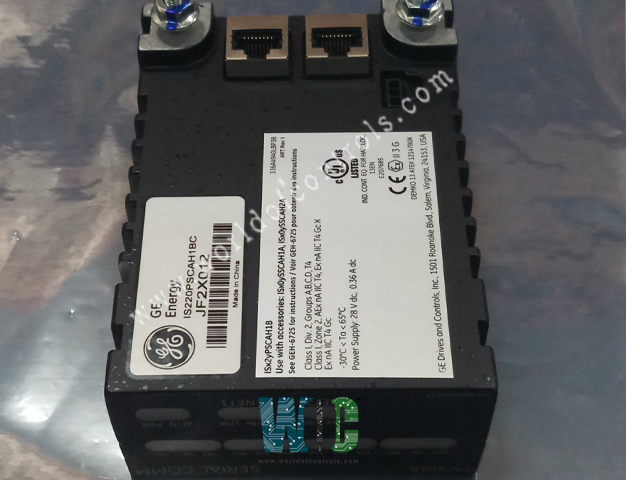SPECIFICATIONS
Part No.: IS220PPDAH1BA
Manufacturer: General Electric
Country of Manufacture: United States of America (USA)
Size: 10.16 cm wide x 33.02 cm high
Temperature: -30 to 65oC
Technology: Surface-mount
Product Type: System Feedback Module
Availability: In Stock
Series: Mark VIe
Functional Description
IS220PPDAH1BA is a System Feedback Module developed by GE. It is a part of Mark VIe control system. The PPDA I/O (Input/Output) pack is a critical interface within the Mark VIe Modular Power Distribution (PDM) system, specifically designed to manage and integrate feedback signals from various power distribution boards.
Features
- Integration of Multiple Power Distribution Boards: The PPDA I/O pack is engineered to accept inputs from a maximum of six distinct power distribution boards. It acts as an interface to consolidate and manage the feedback signals from these boards.
- Conditioning of Board Feedback Signals: Upon receiving feedback signals from the connected power distribution boards, the PPDA I/O pack processes and conditions these signals. This processing ensures that the feedback is appropriately structured and prepared for transmission.
- Dual Redundant Ethernet Interface to Controllers: The PPDA I/O pack provides a dual redundant Ethernet interface. This interface serves as a communication channel, allowing seamless interaction and transmission of processed feedback signals to the controllers within the system.
- Plug-and-Play Design Using Electronic IDs: The PPDA I/O pack implements a plug-and-play design approach facilitated by electronic IDs. These electronic identification mechanisms help in identifying and determining the specific power distribution boards wired into the PPDA I/O pack.
- Utilization of Information for IONet Output: The information obtained from the electronic IDs is leveraged to populate the IONet output. This process ensures that the feedback transmitted from the connected boards is accurately represented and provided through the IONet output.
Compatibility
- Host Boards: The I/O pack is designed to be hosted by specific boards within the Mark VIe Modular Power Distribution (PDM) system. It operates in conjunction with the JPDS or JPDM 28 V DC Control Power boards. These hosting boards provide the platform and support functionalities within the system.
- Compatibility with Feedback Signals: The PPDA I/O pack exhibits compatibility with feedback signals generated by various boards within the system. Specifically, it seamlessly interacts with and effectively manages the feedback signals produced by the following boards:
- JPDB: This board generates specific feedback signals related to power distribution, which are compatible and readable.
- JPDE: Similarly, capable of receiving and processing feedback signals created by the JPDE board, enhancing its interoperability within the system.
- JPDF: The compatibility extends to the feedback signals generated by the JPDF board, allowing the PPDA I/O pack to interact with and interpret the signals for further processing and transmission.
- Significance of Compatibility: Compatibility between the I/O pack and these specific boards ensures a cohesive and harmonized operation within the power distribution system. It allows for efficient communication, accurate signal interpretation, and effective utilization of the feedback signals by the PPDA I/O pack.
- Interoperability for System Functionality: Compatibility with the JPDS, JPDM, JPDB, JPDE, and JPDF boards ensures that it can seamlessly integrate with these components, contributing to the overall functionality and reliability of the Mark VIe Modular Power Distribution (PDM) system.
Installation
- Mounting the Terminal Board: Begin by securely mounting the desired terminal board (JPDS or JPDM) in the designated location.
- Plugging in the I/O Pack: Directly plug either one board for simplex operation or three packs for Triple Modular Redundancy (TMR) configuration into the connectors on the terminal board.
- Securing the Packs: Mechanically secure by using the threaded studs located adjacent to the Ethernet ports. These studs align with a specific mounting bracket corresponding to the terminal board type. Ensure that the bracket's position prevents any right-angle force from being applied to the DC-37 pin connector between the pack and the terminal board. This adjustment typically needs to be done only once during the product's lifecycle.
- Ethernet Cable Connections: Plug in one or two Ethernet cables based on the system configuration. The pack functions seamlessly over either port. When employing dual connections, the standard practice involves connecting ENET1 to the network associated with the R controller.
- Applying Power to the Pack: Power up the pack by inserting the connector on the side of the pack. There's no need to insert this connector with the power removed from the cable. The I/O pack incorporates soft-start capability, regulating current inrush upon power application.
- Configuration of the I/O Pack: Configure the settings of the I/O pack as required for its intended operation and integration within the system.
- Connecting Ribbon Cables: Establish connections by linking ribbon cables from connector J2 on the JPDS or JPDM terminal board to daisy-chain other core boards. This connection facilitates the transmission of information to the I/O pack for processing and utilization within the system.
The WOC team is always available to help you with your Mark VIe requirements. For more information, please contact WOC.
Frequently Asked Questions
What is IS220PPDAH1BA?
It is a System Feedback Module developed by GE under the Mark VIe series.
What is verified in the analog input hardware?
Precision reference voltages are incorporated within the analog input hardware. The system measures values and compares them against expected values to confirm the health and accuracy of the A/D converter circuits.
How are diagnostic signals managed and reset?
Individual diagnostic signals are latched individually. They are then reset using the RESET DIA signal if they transition to a healthy state.
Where can detailed information about individual diagnostics be found?
Detailed information regarding the individual diagnostics is accessible through ToolboxSTTM, providing comprehensive insights into the system's health and status.
